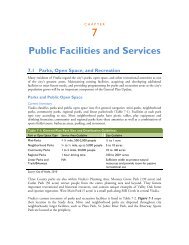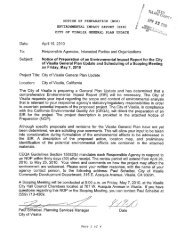General Plan Update Review Committee Draft Elements Part 2 For ...
General Plan Update Review Committee Draft Elements Part 2 For ...
General Plan Update Review Committee Draft Elements Part 2 For ...
You also want an ePaper? Increase the reach of your titles
YUMPU automatically turns print PDFs into web optimized ePapers that Google loves.
Intersection Capacity. The maximum number of<br />
vehicles that has a reasonable expectation of passing<br />
through an intersection in one direction during a<br />
given time period under prevailing roadway and traffic<br />
conditions.<br />
Intrusive Noise. That noise which intrudes over and<br />
above the existing ambient noise at a given location.<br />
The relative intrusiveness of a sound depends upon<br />
its amplitude, duration, frequency, time of occurrence,<br />
and tonal or information content as well as<br />
the prevailing noise level.<br />
ISO Rating. This rating considers a community’s<br />
fire defense capacity versus fire potential, and then<br />
uses the score to set property insurance premiums<br />
for homeowners and commercial property owners.<br />
Jobs-Employed Residents Ratio. Total jobs divided<br />
by total employed residents (i.e. people who live in<br />
the area, but may work anywhere). A ratio of 1.0<br />
typically indicates a balance. A ratio greater than 1.0<br />
indicates a net in-commute; less than 1.0 indicates a<br />
net out-commute.<br />
K Factor. Erosion factor K indicates the susceptibility<br />
of a soil to sheet and rill erosion by water. Factor<br />
K is one of six factors used in the Universal Soil<br />
Loss Equation (USLE) and the Revised Universal<br />
Soil Loss Equation (RUSLE) to predict the average<br />
annual rate of soil loss by sheet and rill erosion in<br />
tons per acre per year. The estimates are based primarily<br />
on percentage of silt, sand, and organic matter<br />
and on soil structure and saturated hydraulic<br />
conductivity (Ksat). Values of K range from 0.02 to<br />
0.69. Other factors being equal, the higher the value,<br />
the more susceptible the soil is to sheet and rill erosion<br />
by water.<br />
L10. A statistical descriptor indicating the sound<br />
level exceeded ten percent of the time. It is a commonly<br />
used descriptor of community noise, and has<br />
been used in Federal Highway Administration standards<br />
and the standards of some cities.<br />
LEED. The Leadership in Energy and Environmental<br />
Design (LEED) Green Building Rating System<br />
is the nationally accepted benchmark for the design,<br />
construction, and operation of high performance<br />
green buildings.<br />
Level of Service, LOS (traffic). A qualitative measure<br />
describing operational conditions within a traffic<br />
stream and the perception of motorists and/or<br />
passengers regarding these conditions. A level of service<br />
definition generally describes these conditions<br />
in terms of such factors as traffic volumes, speed<br />
and travel time, delays at traffic signals, freedom<br />
to maneuver, traffic interruptions, comfort, convenience,<br />
and safety.<br />
Liquefaction. A sudden large decrease in the shearing<br />
resistance of a cohesion less soil, caused by a collapse<br />
of the structure by shock or strain, and associated<br />
with a sudden but temporary increase of the<br />
pore fluid pressure.<br />
Low Impact Development. Site planning and development<br />
features that reduce impermeable surface<br />
areas and increase infiltration, such as use of permeable<br />
paving, vegetated swales, and water retention<br />
facilities.




